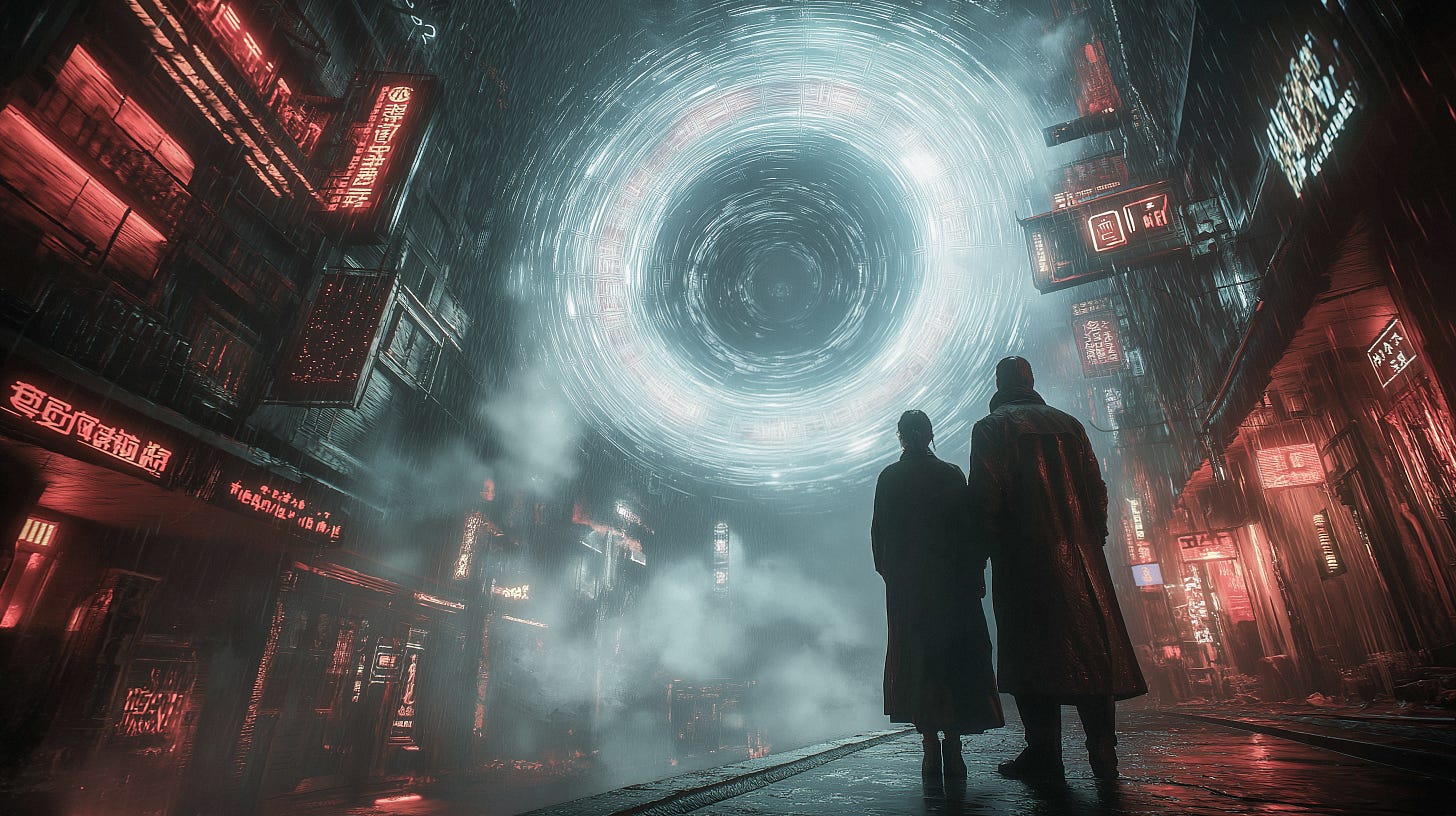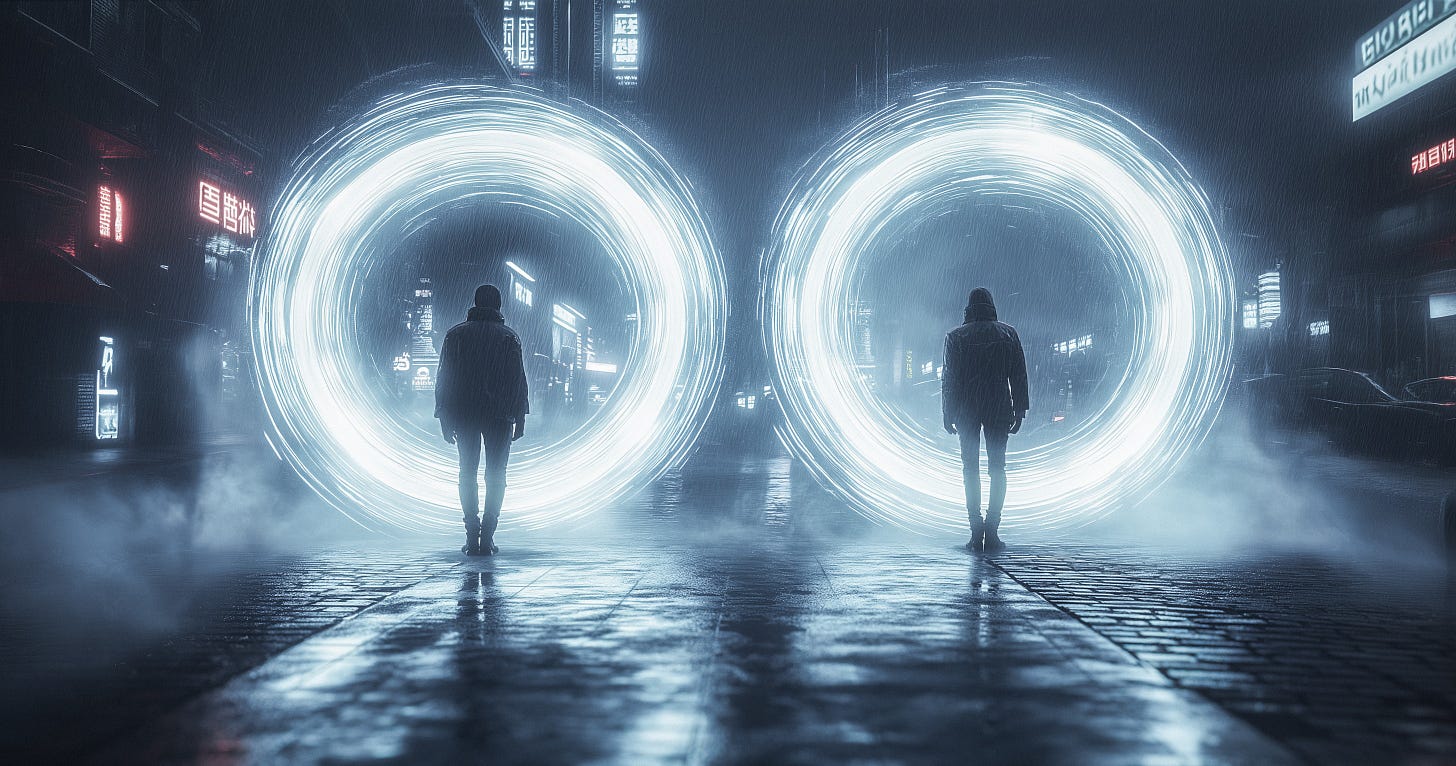Beyond Willpower: The Strange Yet Entirely Reproducible Science of Realizing Ambitions
Cultivating Life Force Part IV: Exploring a Simple Physics Principle That Outperforms Willpower In Just About Every Endeavor
We’ve all marveled at that one person who effortlessly achieves their dreams without remarkable talent, intelligence, effort, willpower, resources, or connections. Shrugging off their success as blind luck, we return to our own relentless grind. Like a prisoner pouring asphalt on a sun-scorched highway, we muster our willpower to stay upright, whistling a tune to make the day bearable...
Do-be-do-be-doo.
Do we know why we try so hard to do the things we do? Is it out of duty, obligation, or simply because someone once told us we should do-do?
The mind weaves an endless web of excuses to keep us from the things we'd love to do. Self-help empires grow on the promise of exposing these deceptions. We sign up for seminars, sip psychoactive brews, dance around bonfires, purge toxins, burn sage—each ritual a step toward some elusive "there," where we finally have the chance to do "it."
Where? What?
Visualization exercises, positive intentions, and active manifestations might be melting snowballs on the moon, but they seem to have little effect here on Earth. And that yellow Post-it note with the three-syllable mantra our guru told us to repeat eleven times before morning coffee? Still stuck on the fridge.
The harder we exert our will, the more we entrench ourselves in our current hole—or worse, dig ourselves into an even deeper one.
Willpower, as a rule, leads us nowhere—or anywhere except our desired state.
The really weird part? No one knows why willpower sucks. Not even the life coaches who command six digits for a single evening of transformative do-be-da-di-dum have a clue why willpower fails to dent the cosmos.
Which leaves us with a question: what is the secret principle out there in the cold space that shapeshifts our destinies like a mad seductress?
What is her modus operandi? Or is she just honking mad, like the trickster character, Q, in Star Trek?
Spotting the Handiwork of the Great Shapeshifter
Turn off your phone and take a stroll through a familiar part of your neighborhood. The next evening, wander through an unfamiliar one. Breathe deeply, observe closely. Do this long enough, and you’ll begin to feel it—the invisible yet undeniable force that gives each street its unique character and draws its inhabitants into its composition.
Depending on how your brain decides to unscramble the data, you might sense a vibe, catch a faint fragrance, hear an elusive tune, or feel a tingle. It doesn't matter—they're all just different translations of the same reality.
I remember how I first started paying attention to this phenomenon in Los Angeles, after living there for three years. Every time I landed at LAX I began to feel and smell a funky layer of cotton candy on my skin. It was LA telling me that I was slowly turning into a cartoon figure - or so I suspected.
The fabric and inhabitants of every city, town, street block—even the cafe on 3rd Street—bear the fingerprints of these peculiar machinations, if we keep our senses tuned.
Observe the pets and their owners—how they've begun to mirror each other's moods, strides, and gazes, sometimes even their barks.
Notice how couples and families sync their gestures and mindsets over time, blending into a collective rhythm—except perhaps for the black sheep who recognizes the trap.
Then there's the classic old couple shuffling across the grassy knoll, clad in matching windbreakers, with downturned mouths and synchronized limps. What kind of alchemy shaped them from the same Play-Doh?
Pay close attention to how groups assimilate almost instantly. A night out, a weekend retreat, a dinner, a sports event—it takes mere moments for individuality (and often IQ) to dissolve in the whirlpool of groupthink.
Notice, too, the quiet rewiring of your own personality when you meet new people--whether they belong to a community, company, club, cult, clique, or sports team. Minute by minute, hour by hour, your quirks nudge toward theirs, adapting to the cadence of the collective.
The moment we step into someone's orbit, our fields begin to intertwine. Our breathing, heartbeats, even brainwaves start to sync in a strange, automatic dance. Lovers, friends, strangers—it doesn't matter. We co-regulate one another with startling speed, triggering cascades of change that can elevate or erode us, depending on the encounter.
That it happens is undeniable. But how it happens remains a conundrum. Chemical or hormonal exchanges are too slow, too clunky to account for the rapid, visceral connection. Esoteric, spiritual, or religious explanations may inspire, but they seldom offer reproducibility. Somehow, information and energy are transferred in ways we don't have a name for.
When certain animals, like the octopus, morph to match their environment--camouflaging themselves within the coral reef—biology calls it mimicry or convergent evolution, fancy words that fail to explain causation.
Modern science, with its reductionist lens, hasn't even begun to ask the crucial question: What medium carries this information?
Yet the answer is as simple as a child dropping two pebbles into a pond and watching the ripples meet, collide, and merge. No need for advanced degrees in physics, evolution, or biology.
We're Like Thirty Trillion Pebbles in a Pond
The smallest unit of life—the cell—regulates our chemistry not just with molecules, but through subtle electric and electromagnetic signals, rippling like waves in a pond. These waves exchange information and energy at speeds modern science can't grasp yet.
What if this same principle governs the flow of energy and information between superorganisms?
Constructive and destructive wave interference—the principle of waves we learned in Physics 1001—may be the simplest, most logical explanation for how we shape each other's lives, just as it explains the internal rhythms of our own bodies.
Let’s play with the idea that our form, our behavior, our identity are sculpted by the environment - especially the beings we cohabit reality with. It may be the reason why willpower feels so futile. We can't bend waves to our will—waves bend us.
In this world, change isn't something to wrestle with. It's something to observe and align with. The right interference patterns will eventually emerge if we stop thrashing against the tide. And when they do, they don't just shift our mindset—they reshape physical reality. Which is why it’s important to observe carefully before surrendering to the flow.
Once we see her in action, it's impossible to unsee. The illusion of control evaporates. We've been tossed about in an ocean of waves, convinced we could master the swells through sheer determination. The realization hits like a cosmic "duh."
Conventional science avoids discussing biological wave interference because of societal programming. The 20th century drilled into us the notion that we are made of particles, not waves. But the truth is far more exciting: we are waves that imagine particles into being.
When we tap into our wave nature, the universe starts to make more sense. We can finally chill a little bit, like the smiling monk sitting under the tree. Things that are happening right now, right here, have already been set in motion, before we came up with the idea of here and now.
Imagine an electronic thermostat. It senses a drop in temperature and sends an immediate signal to the boiler. The boiler, sluggish and mechanical, takes time to hiss, pop, and gurgle its way toward the new equilibrium. Similarly, the electromagnetic fields around us dictate our chemistry and hormones long before they become physiological changes—even longer before they manifest as ideas about ourselves and our reality.
We don’t initiate change. We don’t control it. Our intentions and plans aren’t the drivers of change—they’re merely its echoes. So, what does that leave us?
The Journey From Logic To Reality, From Illness To Wellness
I inherited a mind that valued logic—an unmistakable gift of my German lineage. A few years ago, if someone had mentioned "biofields," I'd have brushed it off as pseudoscientific blah-blah. It wasn't until my early forties, when a serious health crisis left me adrift with no answers from modern medicine, that I began a reluctant journey beyond the confines of logic.
During my search for solutions, I encountered a technology that claimed to measure subtle fluctuations in the biofield. It sounded like classical woo-woo, but desperation has a way of opening doors. The “hard lab data” wasn’t working, so I decided to give the ethereal a shot.
The setup didn't inspire confidence: clunky machines that could have moonlighted as a 1980s stereo system, with two short electric cables attached to my feet. I expected the analysis to consist of gibberish dressed up as placebo, but to my astonishment, that twelve-minute session revealed more about my body than months of costly lab tests and doctor visits.
The scan identified specific microorganisms I'd been battling, pinpointed an injury no one else could have known about, and exposed hidden issues like mitochondrial dysfunction, localized inflammation, and adrenal fatigue. It was a map of my health—clearer and more actionable than anything I'd encountered before.
I was blown away, but also perplexed. If this technology was so accurate, why wasn't it mainstream? There had to be a catch.
Over the next year, I interviewed practitioners from across disciplines—chiropractors, sports therapists, autoimmune experts, nutritionists—all using the same technology to identify and address chronic issues. They spoke cautiously, aware of the stigma and regulatory challenges that kept this method in the shadows. The technology defied conventional paradigms, and that, ironically, gave me hope.
Inspired, I decided to apply the method with some of my nutrition and lifestyle clients. The results were remarkably consistent, aligning with their underlying conditions and providing valuable insights. It gave me a practical way to track their progress using concrete markers. The method was both efficient and cost-effective compared to traditional alternatives. Many of my clients approached it with the same initial skepticism I had, driven by desperation more than belief. Yet, like me, they began to uncover the root causes of their health challenges—not as isolated symptoms to be checked off but as elements of a dynamic, interconnected whole.
After conducting over a thousand biofield measurements, I've come to believe that true healing starts with reframing how we see ourselves. We are not machines with broken parts to be fixed; we are wave patterns, interconnected fields of energy and information.
Everything affects everything else. Thoughts, emotions, beliefs, and biology are all intertwined, shaping and being shaped by the energy around us. One of the most profound forces influencing our well-being is the tension between who we pretend to be and who we truly are.
Don’t get me wrong—there’s no doubt our collective health is under attack by a centralized Big Agri-Pharma-Food paradigm. But it’s a classic case of focusing on the things we can change. We can work the body and mind a lot easier than the system. Regardless, the tail end of this journey always takes us back to our essence.
In the field dimension, nothing can be hidden. When we conform to societal expectations that pull us out of our authentic skins, we deplete life force. Chronic stress, often blamed exclusively on external pressures, is amplified by this misalignment—a form of destructive interference—eroding our vitality long before physical symptoms appear. When we try to fix the issues with pills, supplements, and protocols, it's like trying to stop the tide with brute force. We push ourselves further out of sync.
The opposite happens when we vibe with people, places, or activities that we sense are somehow “real.” A tribe that feels like home, a challenge that sparks a flow state, or a setting that puts a rouge on our cheeks—create constructive interference, generating the type of vitality that can comfortably navigate both a hostile and a friendly environment.
We face a choice in almost every move we make, to move toward authenticity (constructive interference) or inauthenticity (destructive interference).
The modern tendency to prioritize societal expectations and norms — safety, comfort, predictability—comes at a steep price, something we need to be mindful of when evaluating the next set of ripples.
The Strange Interference Case of the Codependent Couple
Codependent relationships teach us about destructive interference. Take this married couple in their mid-thirties: successful, attractive, and happy—at least on the surface.
The husband is the quintessential alpha male—a tech entrepreneur juggling high stress with late-night parties, drugs, and extramarital affairs. He eats junk food, sleeps only a few hours per night, and lives in constant reaction mode, leaving little room for anything else, especially his wife.
The wife is the epitome of health and discipline. Yoga, meditation, clean eating, and a calm demeanor—she projects the art of balance.
Seven years into their marriage, I measured their biofields, analyzing over 200 million subtle electromagnetic indicators. What I found seemed impossible—until we understood the principle of wave interference.
Her biofield showed a massive toxic load: lymphatic blockages, a hormonal system out of whack, systemic inflammation, a suppressed immune system... She was perpetually fatigued and puzzled as to why her health was deteriorating despite her pristine habits.
His biofield, on the other hand, didn’t reflect the level of damage his lifestyle should have caused. Somehow, the consequences of his destructive behavior were being processed elsewhere—by someone else.
Welcome to the world of conjugal interference, where partners share not just emotions.
This phenomenon isn’t unique to romantic couples. It explains why families, close friends, and tight-knit groups often synchronize in health, mindset, energy, and even personality over time. The effect, amplified by proximity, often surpasses the genetic influence of DNA. In fact, epigenetics demonstrates that DNA is shaped by environment, emotions, and interactions, moment by moment.
In the couple’s case, the husband reaped the benefit. While she rigorously pursued optimal health, she also absorbed his toxic lifestyle. Her system, more delicate than his, bore the compounding burden. Over time, the imbalance culminated in a late-stage autoimmune diagnosis. Modern medicine prescribed a regimen that further depleted her vitality.
Ultimately, they found the courage to end their codependency. The separation triggered a wave of changes. The husband, faced with his own energetic downturn, was forced to adopt healthier habits. The wife regained clarity and energy, rebuilding herself after the initial pain of the split. They reinvented their lives, no longer “completing” each other but at least avoiding the reality of “consuming” each other.
The hardest part is shedding the illusion of comfort. Many dysfunctional relationships feel familiar—a pattern most of us fall into when clinging to the past. The “reset” button feels like a plunge into freezing water, but it opens the door to fresh ripples.
The insight gained from understanding the principles of wave interference has the potential to inspire a fundamental shift in our paradigm.
The Opportunity That Lies Ahead
Modern neurobiologists like Robert M. Sapolsky argue that human behavior is entirely dictated by biology and environment, leaving no room for free will. He’s probably right, but someone should remind him that even in the deterministic matrix, cracks exist—and cracks are where the light gets in.
Instead of seeing ourselves as mere outputs of a genetic program, we can imagine being like jellyfish—fluid, malleable wave packets capable of reprogramming ourselves by consciously curating the environments, relationships, and habits that shape the ripples of our lives.
This isn’t about willpower or positive thinking. It’s not about “good” or “bad”—subjective labels that depend on the observer. It’s about developing a simple habit: using every encounter as a litmus test for energy. Ask yourself, “Does this person, place, activity, or thought energize me or deplete me?” No need to judge, criticize, or label—which are just different ways to deplete.
If it depletes you, bypass without attachment.
Even a single inauthentic ripple—especially one cloaked in a smiley face—can derail a team, a project, or a personal dream. Recognize it and move on. No need for a glance back or a parting critique.
Understanding wave interference not only helps us navigate our own lives but also helps us empathize with others—and even make sense of their seemingly irrational beliefs or behaviors. Their thoughts, like ours, are shaped by ripples they didn’t choose. Don’t waste your energy trying to change them. Instead, change the circumstances that shape minds.
Travel to new places. Explore unfamiliar ideas. Disrupt routines. Seek the unpredictable over the comfortable.
The rest—destiny and all the promise it holds—is already in motion, whether you fight it or flow with it.
Which is why, when you find yourself laying molten asphalt on a sun-scorched highway, remember to keep humming.
Do-be-do-be-daa-dum.
APPENDIX
Basic Biofield Terminology
1. Interference
When waves meet, they either amplify each other (constructive interference) or cancel out (destructive interference). This same principle governs our biofields, shaping the constant push and pull of connection and conflict in our interactions.
2. Reflection
Just as light reflects off a mirror, our biofields can mirror the energy of those around us. This is why we unconsciously mimic the emotions, habits, and even postures of those we're close to, syncing without realizing it.
3. Diffraction
When waves encounter obstacles, they bend and continue onward. This explains how strong emotional bonds can survive physical distance, as the energy we share with others can navigate barriers, finding its way back to us.
4. Resonance
Resonance occurs when one vibrating system causes another to vibrate at the same frequency. It's the essence of connection--the spark of recognition when we feel completely in tune with someone on a level that transcends words.
5. Absorption
Just as a sponge soaks up water, our biofields absorb the energy around us. This explains why empaths often feel overwhelmed in crowded spaces or emotionally charged environments, as they take on the frequencies of others.













Why do your 30 trillion cells feel like a self?
https://youtube.com/watch?v=-isMj7XgLF4
I listened to this yesterday and it was amazing to hear how dynamic the brain is to different environments and situations. I troubleshoot complicated machines by "intuition", sensing how the sequence is off.
And biofield is probably measuring the general energy of the body. The more crap is clogging up processes, the less the energy. The immune system is a myth. We have a garbage collection system.
https://barn0346.substack.com/p/you-dont-have-an-immune-system
Wow,
Excellent.
Everything written here resonated with my experience. I don't always have the language but on occasion I have been able to tune in to a wavelength shared by a family or person even if I don't know them at all, and the dynamics of their relationships and struggles are all on that frequency. Their "song" tells their story. You can "hear" it. Sometimes restating to a person what their wave/song communicates about them and their circumstances can be extremely cathartic for them. I do not know how it's done but I have done it many times. It takes a willingness to tune your receiver and just speak back what you hear, even if you don't fully understand it, and even if you can't make a coherent "story," from it.
It is helpful to remember that we are just tweaking our own wave all the time.